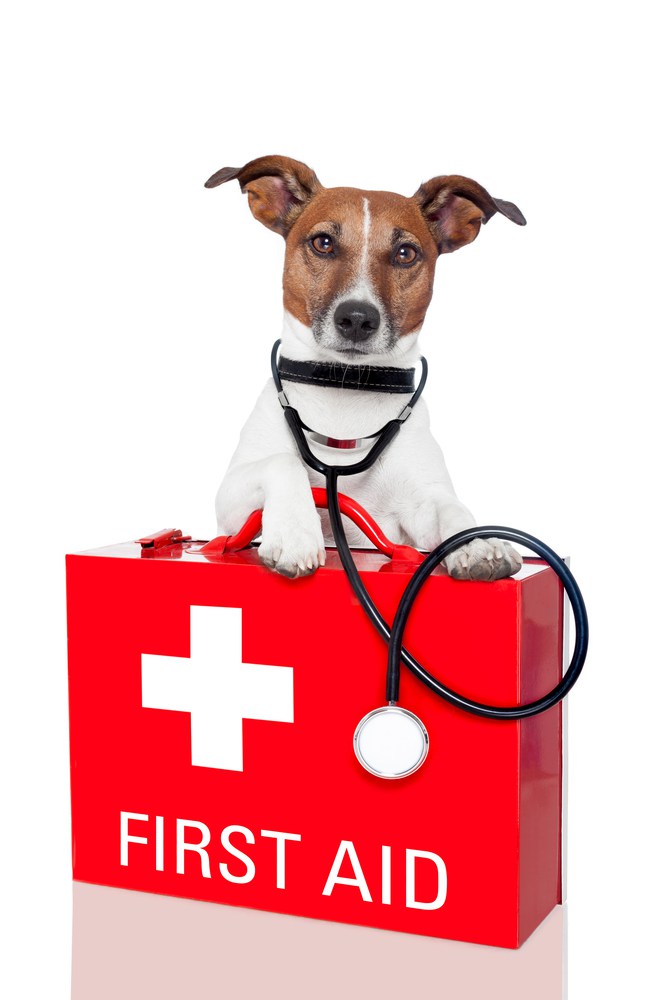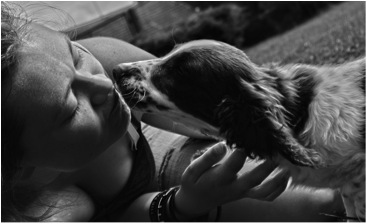We are very pleased to have our guest blogger, Dog Guy Josh, share this wonderful article on how best to be prepared should an emergency or disaster strike. Thank you, Dog Guy Josh!
Pet First Aid and Disaster Preparedness
By Dog Guy Josh
Pet First Aid – A Quick Primer
Pet First Aid: When the unexpected happens and your four-legged friend find himself on the injured list, knowing what to do can help him hurry up and heal so that you can heel!

Define “Normal”
When dealing with injuries and potential illness, you won’t know what’s abnormal if you don’t know what’s normal for your dog to begin with. Take the time to familiarize yourself with your dog’s daily input and output (eating, urinating and defecating) habits, as well as how he moves and breathes and how his body feels under your hands as you pet him. Paying close attention to these details can help you quickly recognize when something might be wrong.
In general, the normal heart rate of a healthy dog is:
100-160 BPM for small, miniature or toy breed dogs (30 lbs or less).
60-100 BPM for medium-to-large breed dogs (30+ lbs).
120-160 BPM for puppies under one-year-old.
The heartbeat of a dog can be felt at the point where the left elbow reaches the chest, along the inner thigh, just below the wrist or just below the hock. Practice under calm conditions to determine which method is most comfortable for you and your pet, as well as to monitor his normal heart rate.
Other “Important Norms” to Know:
The normal breathing rate for a dog is 10-30 breaths per minute or up to 200 pants per minute.
The normal body temperature for a dog is approximately 100.2-102.8 degrees Fahrenheit. Temperatures not within this range should be addressed by a veterinarian.
Capillary refill time (the time it takes the gums or inner lips to return to their normal pink color after you press them) should be between 1-2 seconds.
When pulled upward, the skin at the back of a dog’s neck should spring back to position within 1-2 seconds. A longer return time can indicate dehydration. Dry, sticky gums may also signal dehydration. It’s extremely important that dehydrated animals be taken to a veterinarian for proper care. When in doubt, consult your vet!
The most important information to have on hand during a medical emergency is the name and phone number of the nearest veterinarian and 24-hour veterinary facility. Keep this information on-hand and consider taking a test drive to the local 24-hour facility BEFORE disaster strikes.
Learn Your ABCs!
Whether you’re dealing with pets or people, knowing how to properly administer CPR can mean the difference between life and death! Cardiopulmonary Resuscitation (CPR) is the method used to treat an animal who is not breathing or has no heartbeat. It utilizes rescue breathing and chest compressions and is based on three basic principles which MUST be followed in order:
Airway
Breathing
Circulation
Learning how to properly perform CPR is a wonderful investment in your pet’s future. All pet owners should be proficient in this potentially life-saving, pet first aid skill. Several organizations, including the American Red Cross, offer classes on animal first aid and CPR.
Learn to Recognize a First Aid Emergency
The following medical situations can quickly turn from bad to worse and should be addressed as quickly as possible by a veterinarian:
Shock – The body’s response to a change in blood flow and oxygen to the internal organs. Shock often occurs following sudden blood loss, traumatic injury, severe allergic reaction or infection circulating through the body.
Bloat and Torsion – A condition in which the stomach fills up with air or food, which can cause the stomach to turn around itself, often misplacing the spleen. As this happens, blood supply to the stomach and spleen is lost, damaging the organs and resulting in shock. Bloat and torsion are life-threatening emergencies.
Other emergencies include:
Choking
Bleeding
Allergic Reactions
Luxated (out of joint) or Broken Bones
Breathing Problems
Sudden Trauma
Eye Injuries
Prolonged exposure to extreme temperatures
Training Tips
When preparing for an emergency, it’s as important to train your pet as it is to train yourself! Several easy-to train behaviors can help keep your pet calm and easily accessible during a medical emergency:
Handling and Restraint – Make a habit of handling and gently restraining your pet on a regular basis, rewarding him generously for calm behavior.
Muzzling – Don’t wait until disaster strikes! The best time to introduce your pet to a muzzle is NOT when he’s scared and hurting. Teach him to accept being muzzled by practicing often under calm conditions.
Elizabethan Collar – Like muzzling, teach your pet to calmly tolerate life in an E-Collar under normal conditions.
Confinement – Injured animals often must be confined in order to promote calm behavior necessary for healing. Even if you don’t use a crate on a regular basis, it’s wise to teach your dog to accept spending limited time in a crate or similar confined area.
Disaster Preparedness
Whether your geographic area is prone to earthquakes, fires, hurricanes, tornadoes or other natural disasters, it’s important to have a well thought out household evacuation plan. When planning ahead, consider the following:
Room at the Inn?
If you need to evacuate your home, do not leave your pets behind; they are not likely to survive on their own. For public health reasons, most emergency shelters do not accept pets. Research area hotels/motels that are pet-friendly and identify a few friends and family members who are willing to shelter your pets in an emergency.
May I See Your ID?
Make absolutely certain that your pets wear collars with identification tags at all times. Keep contact information up-to-date. Consider adding a cell phone number or an out-of-area friend or relative to maximize the opportunities for an appropriate caretaker to be contacted regarding your pet. Have your pets microchipped to provide them with a permanent source of identification.
Take Fido “To Go!”
Keep an appropriately sized crate or pet carrier on hand. In the event of a natural disaster, confining your pets in a crate may help prevent injuries from debris. If you do not regularly use a crate, consider occasionally feeding them in their crate to maintain a positive association with confinement.
Packing for Pets
Create a pet survival kit that’s kept in an easily accessible place and contains necessities like 2 weeks worth of pet food, bottled water, food/water bowls, can opener, medications, pet first aid kit and one or more sturdy leashes. Include current medical relevant information about your pet, contact information for your veterinarian as well as for any persons authorized to care for your pet in your absence. It may also be helpful to include a brief medical history and current photo.
Home Away from Home?
Make a list of area boarding facilities, veterinarian offices and shelters. In the event that you are unable to return home right away and need long-term care for your pets, these facilities can assist you in finding appropriate care.
Home Alone?
Not all emergencies take place when you’re home. Designate a nearby friend or family member to check on your pets if necessary. Add a Pet Rescue Sticker to your front door or window to alert rescue personnel of the type and number of animals inside. Stickers can be purchased at most pet stores and are available free of charge at www.aspca.org.
Check out more from Dog Guy Josh
Dog Trainer, Pet Blogger & Business Consultant www.dogguyjosh.com
Resources:
ASPCA at www.aspca.org/pet-care/disaster-preparedness
ASPCA Animal Poison Control Center: (800) 426-4435 or www.aspca.org/pet-care/poison-control
Humane Society of the United States at www.humanesociety.org/about/departments/disaster_preparedness.html
American Red Cross at www.redcross.org
Pettech First Aid & CPR Training at www.pettech.net
Pet First Aid Kits:
www.cpr-savers.com
www.jjdog.com
www.outdoorsafety.net
HSUS Pet First Aid Kit List at www.humanesociety.org/animals/resources/tips/pet_first_aid_kit.html
A Quick Primer on Pet First Aid and Disaster Preparedness
Click To Tweet
This was first published by the Association of Professional Dog Trainers, www.apdt.com, 1-800-PET-DOGS.





 .Broccoli and Other Greens
.Broccoli and Other Greens




 k out
k out 



